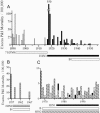Insights into the interaction between influenza virus and pneumococcus
- PMID: 16847087
- PMCID: PMC1539103
- DOI: 10.1128/CMR.00058-05
Insights into the interaction between influenza virus and pneumococcus
Abstract
Bacterial infections following influenza are an important cause of morbidity and mortality worldwide. Based on the historical importance of pneumonia as a cause of death during pandemic influenza, the increasingly likely possibility that highly pathogenic avian influenza viruses will trigger the next worldwide pandemic underscores the need to understand the multiple mechanisms underlying the interaction between influenza virus and bacterial pathogens such as Streptococcus pneumoniae. There is ample evidence to support the historical view that influenza virus alters the lungs in a way that predisposes to adherence, invasion, and induction of disease by pneumococcus. Access to receptors is a key factor and may be facilitated by the virus through epithelial damage, by exposure or up-regulation of receptors, or by provoking the epithelial regeneration response to cytotoxic damage. More recent data indicate that alteration of the immune response by diminishing the ability of the host to clear pneumococcus or by amplification of the inflammatory cascade is another key factor. Identification and exploration of the underlying mechanisms responsible for this synergism will provide targets for prevention and treatment using drugs and vaccines.
Figures

References
-
- Abrahams, A., N. Hallows, and H. French. 1919. A further investigation into influenzo-pneumococcal and influenzo-streptococcal septicaemia. Lancet 1919:1-11.
-
- Abramson, J. S., G. S. Giebink, E. L. Mills, and P. G. Quie. 1981. Polymorphonuclear leukocyte dysfunction during influenza virus infection in chinchillas. J. Infect. Dis. 143:836-845. - PubMed
-
- Alymova, I. V., A. Portner, T. Takimoto, K. L. Boyd, Y. S. Babu, and J. A. McCullers. 2005. The novel parainfluenza virus hemagglutinin-neuraminidase inhibitor BCX 2798 prevents lethal synergism between a paramyxovirus and Streptococcus pneumoniae. Antimicrob. Agents Chemother. 49:398-405. - PMC - PubMed
Publication types
MeSH terms
Grants and funding
LinkOut - more resources
Full Text Sources
Other Literature Sources
Medical

